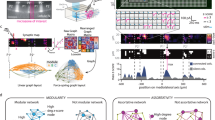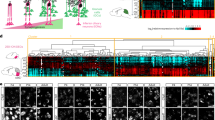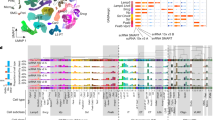Abstract
Secretin (SCT) was first considered to be a gut hormone regulating gastrointestinal functions when discovered. Recently, however, central actions of SCT have drawn intense research interest and are supported by the broad distribution of SCT in specific neuronal populations and by in vivo physiological studies regarding its role in water homeostasis and food intake. The direct action of SCT on a central neuron was first discovered in cerebellar Purkinje cells in which SCT from cerebellar Purkinje cells was found to potentiate GABAergic inhibitory transmission from presynaptic basket cells. Because Purkinje neurons have a major role in motor coordination and learning functions, we hypothesize a behavioral modulatory function for SCT. In this study, we successfully generated a mouse model in which the SCT gene was deleted specifically in Purkinje cells. This mouse line was tested together with SCT knockout and SCT receptor knockout mice in a full battery of behavioral tasks. We found that the knockout of SCT in Purkinje neurons did not affect general motor ability or the anxiety level in open field tests. However, knockout mice did exhibit impairments in neuromuscular strength, motor coordination, and motor learning abilities, as shown by wire hanging, vertical climbing, and rotarod tests. In addition, SCT knockout in Purkinje cells possibly led to the delayed development of motor neurons, as supported by the later occurrence of key neural reflexes. In summary, our data suggest a role in motor coordination and motor learning for SCT expressed in cerebellar Purkinje cells.
Similar content being viewed by others
Log in or create a free account to read this content
Gain free access to this article, as well as selected content from this journal and more on nature.com
or
References
Bayliss WM, Starling EH (1901). The movements and innervation of the small intestine. J Physiol 26: 125–138.
Brooks SP, Dunnett SB (2009). Tests to assess motor phenotype in mice: a user's guide. Nat Rev Neurosci 10: 519–529.
Charlton CG, Miller RL, Crawley JN, Handelmann GE, O'Donohue TL (1983). Secretin modulation of behavioral and physiological functions in the rat. Peptides 4: 739–742.
Cheng CY, Chu JY, Chow BK (2011). Central and peripheral administration of secretin inhibits food intake in mice through the activation of the melanocortin system. Neuropsychopharmacology 36: 459–471.
Chiu CS, Brickley S, Jensen K, Southwell A, McKinney S, Cull-Candy S et al (2005). GABA transporter deficiency causes tremor, ataxia, nervousness, and increased GABA-induced tonic conductance in cerebellum. J Neurosci 25: 3234–3245.
Chu JY, Chung SC, Lam AK, Tam S, Chung SK, Chow BK (2007). Phenotypes developed in secretin receptor-null mice indicated a role for secretin in regulating renal water reabsorption. Mol Cell Biol 27: 2499–2511.
Chu JY, Lee LT, Lai CH, Vaudry H, Chan YS, Yung WH et al (2009). Secretin as a neurohypophysial factor regulating body water homeostasis. Proc Natl Acad Sci USA 106: 15961–15966.
Chu JY, Yung WH, Chow BK (2006). Endogenous release of secretin from the hypothalamus. Ann N Y Acad Sci 1070: 196–200.
Dow RS, Moruzzi G (1958) The Physiology and Pathology of the Cerebellum. University of Minnesota Press.
Erickson MA, Haburcak M, Smukler L, Dunlap K (2007). Altered functional expression of Purkinje cell calcium channels precedes motor dysfunction in tottering mice. Neuroscience 150: 547–555.
Gaveriaux-Ruff C, Kieffer BL (2007). Conditional gene targeting in the mouse nervous system: Insights into brain function and diseases. Pharmacol Ther 113: 619–634.
Grusser-Cornehls U, Baurle J (2001). Mutant mice as a model for cerebellar ataxia. Prog Neurobiol 63: 489–540.
Heinzlmann A, Kiss G, Toth ZE, Dochnal R, Pal A, Sipos I et al (2012). Intranasal application of secretin, similarly to intracerebroventricular administration, influences the motor behavior of mice probably through specific receptors. J Mol Neurosci 48: 558–564.
Heyser CJ (2001). Assessment of developmental milestones in rodents. Curr Protoc Neurosci. John Wiley & Sons, Inc.
Hickey MA, Kosmalska A, Enayati J, Cohen R, Zeitlin S, Levine MS et al (2008). Extensive early motor and non-motor behavioral deficits are followed by striatal neuronal loss in knock-in Huntington's disease mice. Neuroscience 157: 280–295.
Hwang DW, Givens B, Nishijima I (2009). Ethanol-induced developmental neurodegeneration in secretin receptor-deficient mice. Neuroreport 20: 698–701.
Ito M (1984). The modifiable neuronal network of the cerebellum. Jpn J Physiol 34: 781–792.
Ito M (2002). Historical review of the significance of the cerebellum and the role of Purkinje cells in motor learning. Ann N Y Acad Sci 978: 273–288.
Jukkola PI, Rogers JT, Kaspar BK, Weeber EJ, Nishijima I (2011). Secretin deficiency causes impairment in survival of neural progenitor cells in mice. Hum Mol Genet 20: 1000–1007.
Karl T, Pabst R, von Horsten S (2003). Behavioral phenotyping of mice in pharmacological and toxicological research. Exp Toxicol Pathol 55: 69–83.
Kim HS, Yumkham S, Kim SH, Yea K, Shin YC, Ryu SH et al (2006). Secretin induces neurite outgrowth of PC12 through cAMP-mitogen-activated protein kinase pathway. Exp Mol Med 38: 85–93.
Koves K, Kiss G, Heinzlmann A, Dochnal R, Manczinger M, Pal A et al (2011). Secretin attenuates the hereditary repetitive hyperactive movements in a mouse model. J Mol Neurosci 43: 109–114.
Lalonde R, Strazielle C (2007). Spontaneous and induced mouse mutations with cerebellar dysfunctions: behavior and neurochemistry. Brain Res 1140: 51–74.
Lamont MG, Weber JT (2012). The role of calcium in synaptic plasticity and motor learning in the cerebellar cortex. Neurosci Biobehav Rev 36: 1153–1162.
Lee SM, Chen L, Chow BK, Yung WH (2005). Endogenous release and multiple actions of secretin in the rat cerebellum. Neuroscience 134: 377–386.
Lee VH, Lee LT, Chu JY, Lam IP, Siu FK, Vaudry H et al (2010). An indispensable role of secretin in mediating the osmoregulatory functions of angiotensin II. FASEB J 24: 5024–5032.
Martin LA, Goldowitz D, Mittleman G (2010). Repetitive behavior and increased activity in mice with Purkinje cell loss: a model for understanding the role of cerebellar pathology in autism. Eur J Neurosci 31: 544–555.
Miyakawa T, Yared E, Pak JH, Huang FL, Huang KP, Crawley JN (2001). Neurogranin null mutant mice display performance deficits on spatial learning tasks with anxiety related components. Hippocampus 11: 763–775.
Mocholi E, Ballester-Lurbe B, Arque G, Poch E, Peris B, Guerri C et al (2011). RhoE deficiency produces postnatal lethality, profound motor deficits and neurodevelopmental delay in mice. PLoS one 6: e19236.
Ng SS, Yung WH, Chow BK (2002). Secretin as a neuropeptide. Mol Neurobiol 26: 97–107.
Nishijima I, Yamagata T, Spencer CM, Weeber EJ, Alekseyenko O, Sweatt JD et al (2006). Secretin receptor-deficient mice exhibit impaired synaptic plasticity and social behavior. Hum Mol Genet 15: 3241–3250.
O'Donohue TL, Charlton CG, Miller RL, Boden G, Jacobowitz DM (1981). Identification, characterization, and distribution of secretin immunoreactivity in rat and pig brain. Proc Natl Acad Sci USA 78: 5221–5224.
Paylor R, Nguyen M, Crawley JN, Patrick J, Beaudet A, Orr-Urtreger A (1998). Alpha7 nicotinic receptor subunits are not necessary for hippocampal-dependent learning or sensorimotor gating: a behavioral characterization of Acra7-deficient mice. Learn Mem 5: 302–316.
Sacchetti B, Scelfo B, Strata P (2005). The cerebellum: synaptic changes and fear conditioning. Neuroscientist 11: 217–227.
Seo HJ, Ham HD, Jin HY, Lee WH, Hwang HS, Park SA et al (2010). Chronic administration of monosodium glutamate under chronic variable stress impaired hypothalamic-pituitary-adrenal axis function in rats. Korean J Physiol Pharmacol 14: 213–221.
Siu FK, Sham MH, Chow BK (2005). Secretin, a known gastrointestinal peptide, is widely expressed during mouse embryonic development. Gene Expr Patterns 5: 445–451.
Siu FK, Sham MH, Chow BK (2006). The prenatal expression of secretin receptor. Ann N Y Acad Sci 1070: 561–565.
Southan AP, Robertson B (1998). Modulation of inhibitory post-synaptic currents (IPSCs) in mouse cerebellar Purkinje and basket cells by snake and scorpion toxin K+ channel blockers. Br J Pharmacol 125: 1375–1381.
Swinny JD, van der Want JJ, Gramsbergen A (2005). Cerebellar development and plasticity: perspectives for motor coordination strategies, for motor skills, and for therapy. Neural Plast 12: 153–160.
Takahashi E, Niimi K, Itakura C (2009). Motor coordination impairment in aged heterozygous rolling Nagoya, Cav2.1 mutant mice. Brain Res 1279: 50–57.
Thach WT, Goodkin HP, Keating JG (1992). The cerebellum and the adaptive coordination of movement. Annu Rev Neurosci 15: 403–442.
Williams MR, Fuchs JR, Green JT, Morielli AD (2012). Cellular mechanisms and behavioral consequences of Kv1.2 regulation in the rat cerebellum. J Neurosci 32: 9228–9237.
Yu F, Liao Y, Jin Y, Zhao Y, Ren Y, Lu C et al (2008). Effects of in utero meso-2,3-dimercaptosuccinic acid with calcium and ascorbic acid on lead-induced fetal development. Arch Toxicol 82: 453–459.
Yung WH, Leung PS, Ng SS, Zhang J, Chan SC, Chow BK (2001). Secretin facilitates GABA transmission in the cerebellum. J Neurosci 21: 7063–7068.
Zhang XM, Ng AH, Tanner JA, Wu WT, Copeland NG, Jenkins NA et al (2004). Highly restricted expression of Cre recombinase in cerebellar Purkinje cells. Genesis 40: 45–51.
Acknowledgements
This work was supported by HK government RGC Grant GRF 764510, 765113, and CRF grant HKU6/CRF/11G to BKC Chow. We thank Ms Lisa Zhang for her kind help in the open field test and Mr Hans Ng in helping preparing ISH experiments.
Author information
Authors and Affiliations
Corresponding author
Rights and permissions
About this article
Cite this article
Zhang, L., Chung, S. & Chow, B. The Knockout of Secretin in Cerebellar Purkinje Cells Impairs Mouse Motor Coordination and Motor Learning. Neuropsychopharmacol 39, 1460–1468 (2014). https://doi.org/10.1038/npp.2013.344
Received:
Revised:
Accepted:
Published:
Issue date:
DOI: https://doi.org/10.1038/npp.2013.344
Keywords
This article is cited by
-
The Novel Potential Therapeutic Utility of Montelukast in Alleviating Autistic Behavior Induced by Early Postnatal Administration of Thimerosal in Mice
Cellular and Molecular Neurobiology (2021)
-
Distribution and Functional Implication of Secretin in Multiple Brain Regions
Journal of Molecular Neuroscience (2019)
-
A modified formulation of Huanglian-Jie-Du-Tang reduces memory impairments and β-amyloid plaques in a triple transgenic mouse model of Alzheimer’s disease
Scientific Reports (2017)



